
Wetenschap
Nanomechanische studie biedt nieuwe beoordeling van silicium voor batterijen van de volgende generatie
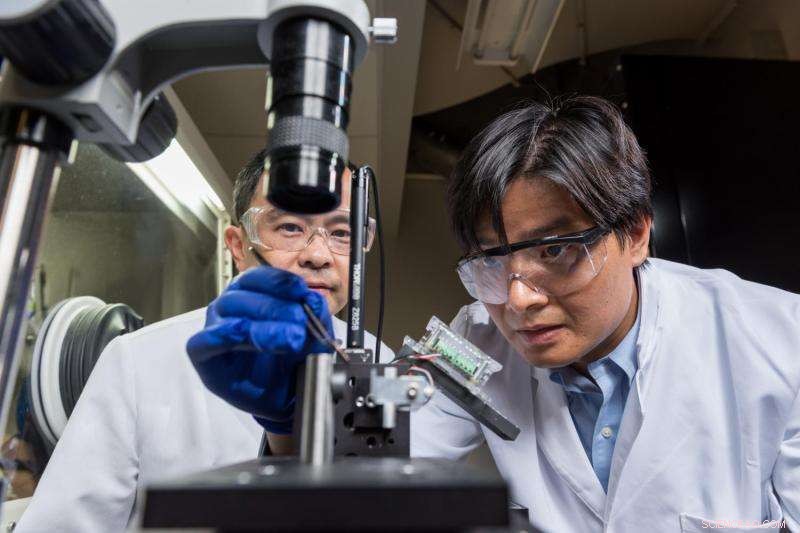
Professor Ting Zhu en assistent-professor Suman Xia, beide van de Woodruff School of Mechanical Engineering van Georgia Tech, laten zien hoe een dunnefilmelektrode gemaakt van amorf silicium werd getest in een speciaal milieu-indenter. Om een goede omgevingscontrole te bieden, monsters met gelithieerd silicium werden getest met het apparaat in het handschoenenkastje op de achtergrond. Krediet:Rob Vilt, Georgië Tech
Een gedetailleerde nanomechanische studie van mechanische afbraakprocessen in siliciumstructuren die verschillende niveaus van lithiumionen bevatten, biedt goed nieuws voor onderzoekers die betrouwbare oplaadbare batterijen van de volgende generatie proberen te ontwikkelen met behulp van op silicium gebaseerde elektroden.
Anodes - de negatieve elektroden - op basis van silicium kunnen theoretisch tot tien keer meer lithiumionen opslaan dan conventionele grafietelektroden, waardoor het materiaal aantrekkelijk is voor gebruik in hoogwaardige lithium-ionbatterijen. Echter, de broosheid van het materiaal heeft pogingen ontmoedigd om puur silicium te gebruiken in batterijanoden, die bestand moet zijn tegen dramatische volumeveranderingen tijdens laad- en ontlaadcycli.
Met behulp van een combinatie van experimentele en simulatietechnieken, onderzoekers van het Georgia Institute of Technology en drie andere onderzoeksorganisaties hebben een verrassend hoge schadetolerantie gerapporteerd in elektrochemisch gelithieerde siliciummaterialen. Het werk suggereert dat volledig siliciumanodes commercieel levensvatbaar kunnen zijn als de laadniveaus van de batterij hoog genoeg worden gehouden om het materiaal in zijn ductiele staat te houden.
Ondersteund door de National Science Foundation, het onderzoek wordt op 24 september gerapporteerd in het tijdschrift Natuurcommunicatie .
"Silicium heeft een zeer hoge theoretische capaciteit, maar vanwege de waargenomen mechanische problemen, mensen zijn gefrustreerd over het gebruik ervan in batterijen van de volgende generatie, " zei Shuman Xia, een assistent-professor aan de George W. Woodruff School of Mechanical Engineering aan de Georgia Tech. "Maar ons onderzoek toont aan dat gelithieerd silicium niet zo broos is als we misschien dachten. Als we zorgvuldig werken met het operationele venster en de diepte van de ontlading, onze resultaten suggereren dat we potentieel zeer duurzame op silicium gebaseerde batterijen kunnen ontwerpen."
Lithium-ionbatterijen worden tegenwoordig gebruikt in een breed scala aan toepassingen, van draagbare mobiele apparaten tot laptops en elektrische voertuigen. Een nieuwe generatie batterijen met hoge capaciteit zou uitgebreide transporttoepassingen en grootschalige opslag van elektriciteit uit hernieuwbare bronnen kunnen vergemakkelijken.
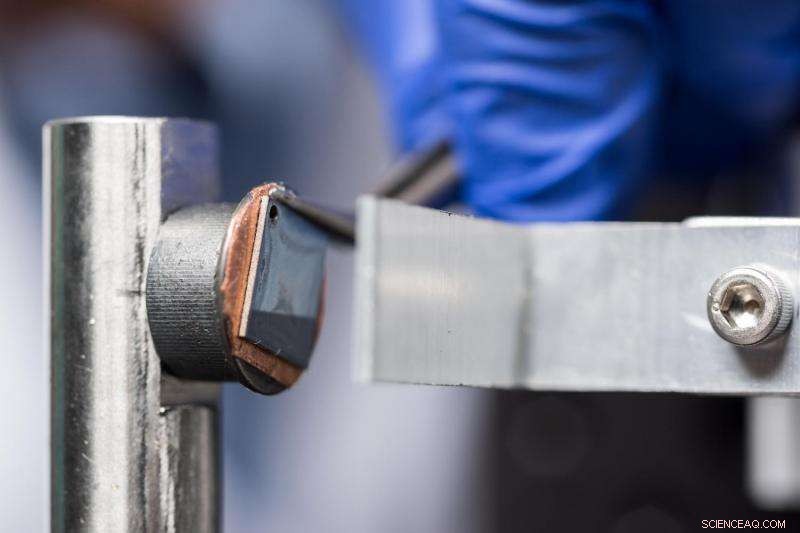
Getoond worden details van een aangepaste omgevingsindenter die wordt gebruikt om dunne-filmelektroden gemaakt van amorf silicium te testen. Het apparaat werd gebruikt om een gedetailleerde nanomechanische studie van mechanische afbraakprocessen in dunne siliciumfilms te ontwikkelen. Krediet:Rob Vilt, Georgië Tech
De uitdaging is om meer lithiumionen in de anodes en kathodes van de batterijen te krijgen. De huidige lithiumbatterijen gebruiken grafietanodes, maar silicium is geïdentificeerd als een alternatief omdat het aanzienlijk meer lithiumionen per atoom kan opslaan. Echter, het opslaan van die ionen produceert een volumeverandering tot 280 procent, spanning veroorzaken die anodes gemaakt van puur silicium kan kraken, wat leidt tot een aanzienlijke prestatievermindering. Een strategie is om een composiet van siliciumdeeltjes en grafiet te gebruiken, maar dat realiseert niet het volledige potentieel van silicium voor het vergroten van de batterijcapaciteit.
In een poging om te begrijpen wat er met de materialen gebeurde, het onderzoeksteam gebruikte een reeks systematische nanomechanische tests, ondersteund door moleculaire dynamische simulaties. Om hun studie te vergemakkelijken, ze gebruikten silicium nanodraden en elektrochemische cellen die siliciumfilms bevatten die ongeveer 300 nanometer dik waren.
The researchers studied the stress produced by lithiation of the silicon thin films, and used a nanoindenter - a tiny tip used to apply pressure on the film surface - to study crack propagation in these thin films, which contained varying amounts of lithium ions. Lithium-lean silicon cracked under the indentation stress, but the researchers were surprised to find that above a certain concentration of lithium, they could no longer crack the thin film samples.
Using unique experimental equipment to assess the effects of mechanical bending on partially lithiated silcon nanotires, researchers led by Professor Scott Mao at the University of Pittsburgh studied the nanowire damage mechanisms in real-time using a transmission electron microscope (TEM). Their in-situ testing showed that the silicon cores of the nanowires remained brittle, while the outer portion of the wires became more ductile as they absorbed lithium.
"Our nanoindentation and TEM experiments were very consistent, " said Xia. "Both suggest that lithiated silicon material becomes very tolerant of damage as the lithium concentration goes above a certain level - a lithium-to-silicon molar ratio of about 1.5. Beyond this level, we can't even induce cracking with very large indentation loads."
Ting Zhu, a professor in Woodruff School of Mechanical Engineering at Georgia Tech, conducted detailed molecular dynamics simulations to understand what was happening in the electrochemically-lithiated silicon. As more lithium entered the silicon structures, he found, the ductile lithium-lithium and lithium-silicon bonds overcame the brittleness of the silicon-silicon bonds, giving the resulting lithium-silicon alloy more desirable fracture strength.
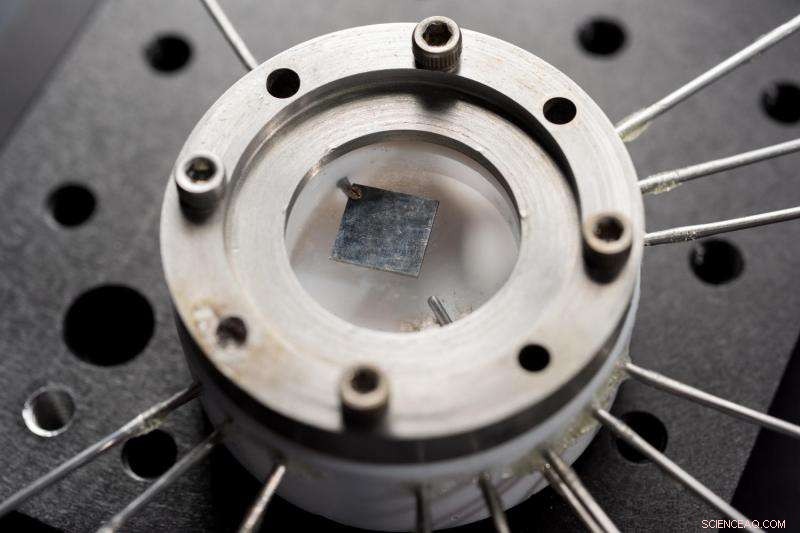
Shown is a sample holder used to test samples of lithiated silicon to determine its nano-mechanical properties. The device was used to develop a detailed nano-mechanical study of mechanical degradation processes in silicon thin films. Credit:Rob Felt, Georgië Tech
"In our simulation of lithium-rich alloys, the lithium-lithium bonds dominate, " Zhu said. "The formation of damage and propagation of cracking can be effectively suppressed due to the large fraction of lithium-lithium and lithium-silicon bonds. Our simulation revealed the underpinnings of the alloy's transition from a brittle state to a ductile state."
Using the results of the studies, the researchers charted the changing mechanical properties of the silicon structures as a function of their lithium content. By suggesting a range of operating conditions under which the silicon remains ductile, Xia hopes the work will cause battery engineers to take a new look at all-silicon electrodes.
"Our work has fundamental and immediate implications for the development of high-capacity lithium-based batteries, both from practical and fundamental points of view, " he said. "Lithiated silicon can have a very high damage tolerance beyond a threshold value of lithium concentration. This tells us that silicon-based batteries could be made very durable if we carefully control the depth of discharge."
Bij toekomstig werk, Xia and Zhu hope to study the mechanical properties of germanium, another potential anode material for high-rate rechargeable lithium-ion batteries. They will also look at all-solid batteries, which would operate without a liquid electrolyte to shuttle ions between the two electrodes. "We hope to find a solid electrolyte with both high lithium ion conductivity and good mechanical strength for replacing the current liquid electrolytes that are highly flammable, " Zhu said.
"The research framework we have developed here is of general applicability to a very wide range of electrode materials, " Xia noted. "We believe this work will stimulate a lot of new directions in battery research."
 Schoon drinkwater krijgen in afgelegen inheemse gemeenschappen betekent het overwinnen van stadsdenken
Schoon drinkwater krijgen in afgelegen inheemse gemeenschappen betekent het overwinnen van stadsdenken Ingenieurs verbeteren ons vermogen om stormvloeden in kaart te brengen
Ingenieurs verbeteren ons vermogen om stormvloeden in kaart te brengen Definitie van een landecosysteem
Definitie van een landecosysteem
Een ecosysteem op het land of op het land is alle levende organismen en hun fysieke omgeving op een bepaald stuk land. Terrestrische ecosystemen kunnen interageren en overlappen met mariene (zoutwater) en limnologis
 Wat zijn Darwins vier belangrijke ideeën over evolutie?
Wat zijn Darwins vier belangrijke ideeën over evolutie?  Kunstmatige intelligentie en satelliettechnologieën onthullen gedetailleerde kaart van luchtvervuiling in het VK
Kunstmatige intelligentie en satelliettechnologieën onthullen gedetailleerde kaart van luchtvervuiling in het VK
Hoofdlijnen
- Wat een grote handtekening kan zeggen over je persoonlijkheid
- Honden in de winter beschermen tegen extreme kou, ijs, zout en deicers
- Hoe bijen hun weg naar huis vinden
- Tagged slakken om onderzoekers te helpen de groei van de slakkenpopulatie te volgen
- De oudste kleur van de aarde was roze
- Caribische bidsprinkhanen hebben een oude Afrikaanse oorsprong
- Waarom is chemie belangrijk voor de studie van anatomie en fysiologie?
- Wat is een interne regulator van de celcyclus?
- Wat is een Gamete?
- Wetenschappers ontwikkelen eerste stof om automatisch te koelen of te isoleren, afhankelijk van de omstandigheden
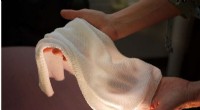
- Koolstof nanobuisjes bootsen biologie na
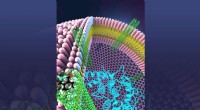
- Een tandemkatalysator op nanoschaal gebruiken om meer propyleen uit propaan te halen tijdens dehydrogenering
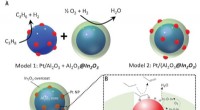
- Slimme huid wordt aangedreven door de objecten die het aanraakt
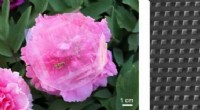
- Glas heeft nu slimme potentie
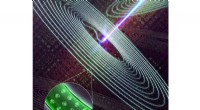
 Hoe versnelling te berekenen met wrijving
Hoe versnelling te berekenen met wrijving Wetenschappers brouwen lava en blazen het op om vulkanen beter te begrijpen
Wetenschappers brouwen lava en blazen het op om vulkanen beter te begrijpen The Science Behind the Egg Drop Experiment
The Science Behind the Egg Drop Experiment  Ozonchemie meten in een bewoonde woning
Ozonchemie meten in een bewoonde woning Onderzoekers ontdekken een systeem met zes planeten met een resonantie van bijna 3:2
Onderzoekers ontdekken een systeem met zes planeten met een resonantie van bijna 3:2 Simulatie:stof had zich gelijkmatig over de aarde kunnen verspreiden na de inslag van de Chicxulub-asteroïde
Simulatie:stof had zich gelijkmatig over de aarde kunnen verspreiden na de inslag van de Chicxulub-asteroïde Wat is een diatome molecule?
Wat is een diatome molecule?  Natuurkundigen verlagen de drempel voor het detecteren van extreem zwakke magnetische signalen
Natuurkundigen verlagen de drempel voor het detecteren van extreem zwakke magnetische signalen
- Elektronica
- Biologie
- Zonsverduistering
- Wiskunde
- French | Italian | Spanish | Portuguese | German | Dutch | Danish | Swedish | Norway |

-
Wetenschap © https://nl.scienceaq.com

